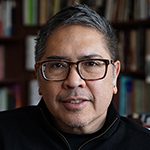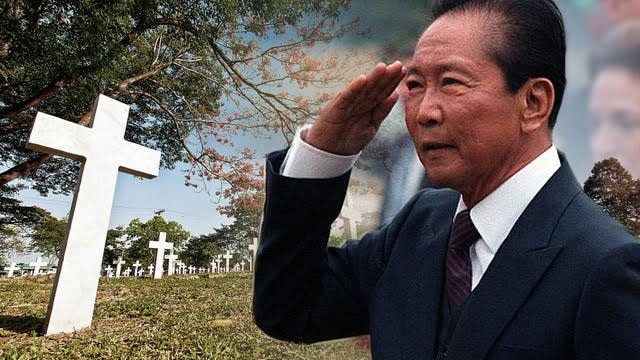SUMMARY
This is AI generated summarization, which may have errors. For context, always refer to the full article.

What is at stake in the Marcos burial controversy?
Some well-meaning folks have tended to downplay it, saying it might actually be a good way to put the Marcos controversy behind us. It will heal the country, they say, and set aside a distraction that will allow everyone else to focus on issues that really matter. Let the dead get their due and the past rest in peace, they say.
But can there be peace without justice? That’s the first question that the Marcos burial raises. Can one commit as well as authorize the commission of the most heinous crimes in the nation’s history and get away with it? And not only get away with it, but profit tremendously in the process?
Second, the Marcos burial is not about healing the rifts within the nation. There cannot be any healing without accountability, and there cannot be accountability without the admission of guilt and making up for past wrongs. There cannot be reconciliation so long as the loot has not been returned, with interest.
Third, the Marcos burial does not mark an end, as one might expect with burials, but really the next stage in the continuing attempt of the Marcoses to return to power. This began almost immediately after they left Malacañang in 1986. They brought with them as much jewelry and money as they could carry in order to reconstitute a grand life in their mansion in Makiki in Oahu (I know, I was teaching at the Univ. of Hawai’i at that time and kept seeing them in the news). They used their money to plot their return, allegedly funding failed coup attempts against the Cory administration (as suggested by declassified FBI documents).
Thanks to their wealth, they not only managed to maintain a standard of life they were accustomed to, but also to provide for the education of the future generation of Marcoses to continue the Marcos legacy (for example, Bongbong’s son who is attending the London School of Economics using presumably the money they stole from the country. London, last I looked, is an extremely expensive city to live in. One wonders where he would live).
More recently, Marcos’s stolen wealth has funded Bongbong’s campaign for the vice-presidency and sustained his legal challenges to Leni Robredo. He has accused Leni of cheating as if he himself was wholly innocent of any wrong-doing. It is not a coincidence that the burial of Marcos is happening at the same time that Bongbong continues his campaign to thank his supporters. Should he win in his protest, he will most likely be catapulted (given all the rumors around Duterte’s ill-health) to the presidency. And once in the Palace, the thievery will undoubtedly continue alongside elaborate programs of development, a la his father.
Hence, the Marcos burial should be seen as part of a long game designed to return them to power. By 1992 – a mere six years after his overthrow – President Ramos, Ferdinand’s second cousin and one of the leaders of the EDSA uprising, allowed Marcos’s body to return, with the understanding that he would be buried in Ilocos. Instead, the corpse was preserved, or at least a wax-figure semblance was kept in a kitschy crypt for his followers to worship.
Every succeeding president has aided and abetted the rehabilitation of the Marcoses: Erap and GMA sought their support and friendship; and PNoy not only tolerated the Marcoses (while his sister, Kris, was outwardly very friendly with Bongbong), he remained uninterested in pursuing the culprits behind his father’s murder.
Imelda followed her husband’s corpse and while beating back numerous court cases, has held on to a seat in Congress, representing her husband’s district in Ilocos. Bongbong and Imee quickly retrieved their provincial base of power and utilized it to secure a foothold in the national legislature. Irene, the quiet one, continues to be a patron of the arts, radiating an innocence and intelligence that is meant to neutralize any negative views of her family.

Filipino elites, both national and provincial, have long embraced the Marcoses back into their fold, recognizing them as one of their own. Society pages and TV shows have avidly followed them as they made their way through the country’s charmed circles. Today they move freely among artists and academics, business tycoons and politicians, and even the Church has welcomed them back.
Revising history
Meanwhile, memories of Martial Law’s horrors have subsided. This in part has been aided by an educational system that has not only revised to the point of erasure the catastrophe of the Marcos years, but also by a well-funded Public Relations machine that has elevated the Marcos accomplishments to the exclusion of the nastier aspects of his regime.
Even more significant, the Marcos cronies and henchmen have all returned. Indeed, they’ve never left, occupying important positions in business, Congress, the military, and journalism. Like those who collaborated with the Japanese during World War II, no one in the Marcos regime has ever been punished, nor held accountable, nor embarrassed and called out for the crimes they had committed. Instead, they have been elected to office and have become insanely wealthy. In the case of at least one crony, Cesar Virata, a school in UP was named after him. A massive lobotomy has ensued.
Duterte was and is part and parcel of that lobotomizing and revisionary process.
As with all the previous presidents, he represents an instance, albeit an important one, in the recuperation and revision of Marcos’s legacy. It’s no secret that he’s an admirer of Marcos. His father served in the Marcos cabinet and there’s some evidence that he actively participated in plotting coups against Cory as a member of the Guardian Brotherhood.
By allowing Marcos’s burial, Duterte pays tribute to his political as well as biological fathers. But by honoring Marcos, he also willfuly dishonors those who suffered under the dictator, just as he deliberately, even maliciously, disregards the sufferings of the families of those killed in his war on drugs.
Additionally, the honor granted to Marcos flies in the face of evidence marshaled by the National Historical Commission that shows that Marcs was guilty of fraudulent representation of his military records. There is thus a peculiar symmetry between Duterte’s mania for extra-judicial killings and Marcos’s cruel authoritarianism. Assuming themselves to be above the law, both have governed arbitrarily beneath the veneer of political necessity.
Marcos is dead, more dead than he has ever been. But in Duterte and the Marcos family, his specter returns to haunt us once again. – Rappler.com
Add a comment
How does this make you feel?
There are no comments yet. Add your comment to start the conversation.